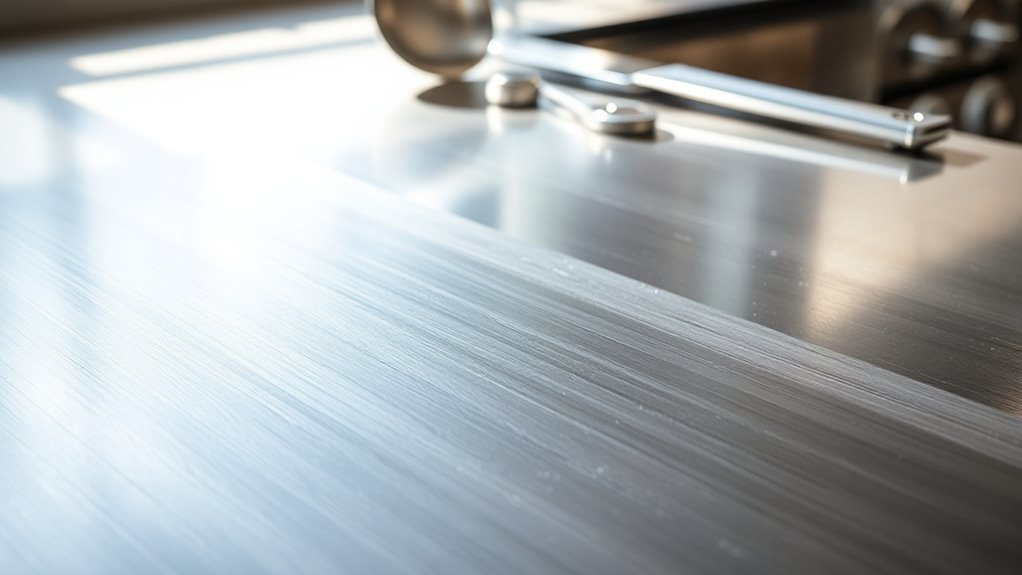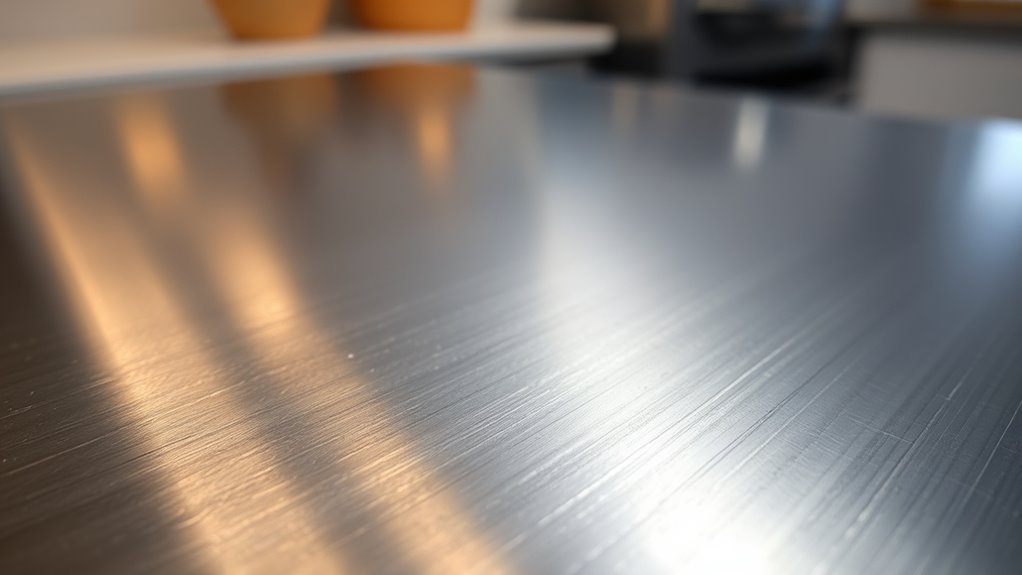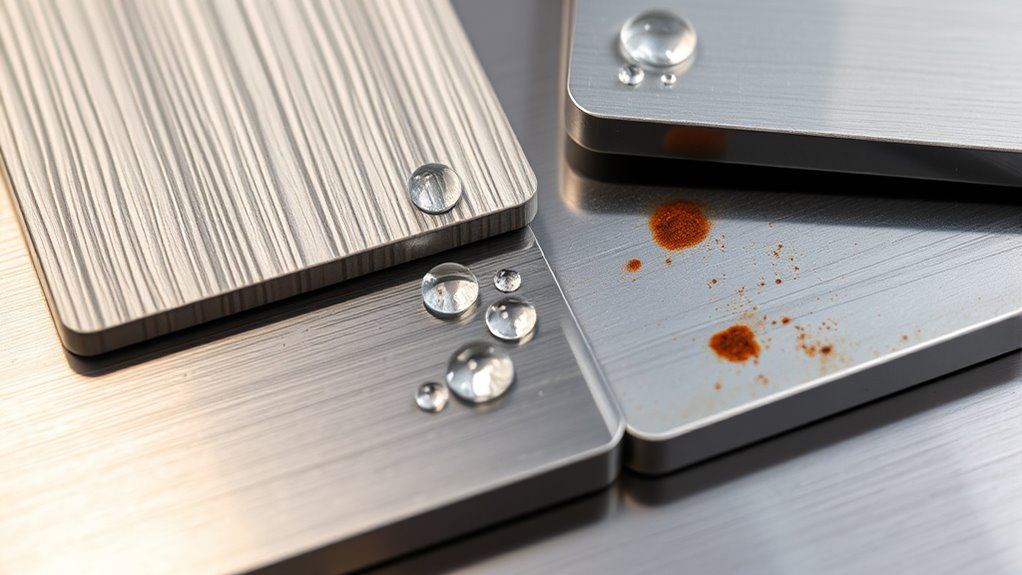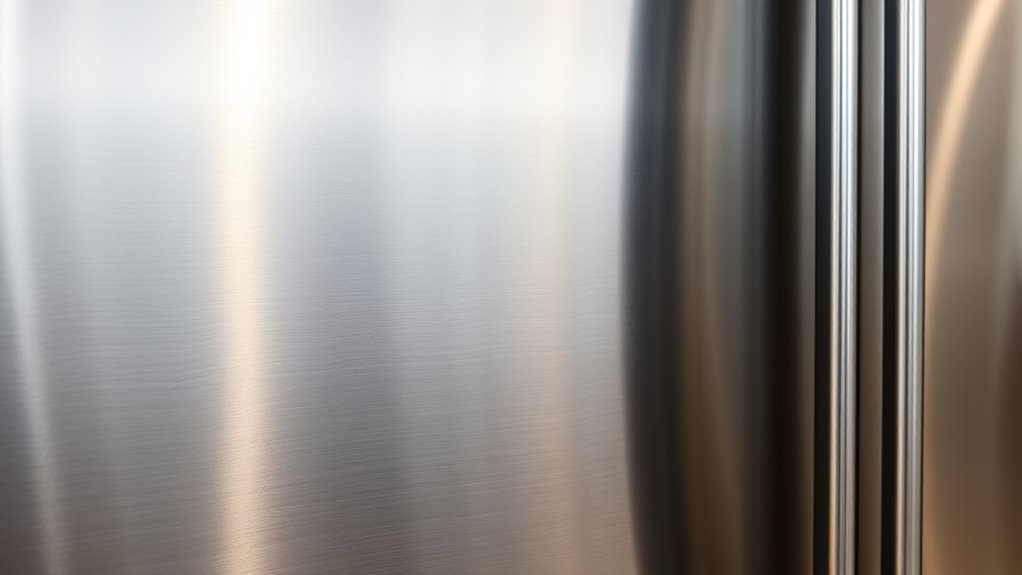Stainless steel comes in different grades like 304 and 316, each suited for specific uses. Grade 304 offers a shiny, smooth look perfect for indoor kitchen items, while 316 has molybdenum for better outdoor and wet environments. Thicker sheets and quality finishes mean longer-lasting, more durable products. Understanding these differences helps you choose the best material for your needs. To discover which grade fits your space and how to spot quality, explore further.
Key Takeaways
- Grade 304 is versatile, corrosion-resistant, with a shiny finish, ideal for indoor kitchen use and easy cleaning.
- Grade 316 contains molybdenum, offering superior resistance to chloride corrosion, suitable for outdoor and marine environments.
- Thicker stainless steel sheets generally offer increased durability and longevity, while surface quality indicates manufacturing standards.
- Surface treatments and finishes reflect product quality; consistent, smooth surfaces resist rust and enhance appearance.
- Choosing the right grade depends on application, environment, aesthetic preferences, and budget, balancing durability and style.
Understanding the Basics of Stainless Steel

Stainless steel is a versatile alloy known for its corrosion resistance and durability, making it a popular choice across many industries. Its alloy composition typically includes iron, chromium, and other elements like nickel or molybdenum, which enhance its properties. The specific mix of these elements influences the steel’s strength, corrosion resistance, and appearance. Manufacturing processes play a vital role in shaping the final product, involving techniques like melting, casting, hot and cold working, and finishing. These processes determine the steel’s microstructure and surface quality, affecting its performance in different applications. Understanding the basics of alloy composition and manufacturing methods helps you appreciate why stainless steel is so widely used and how different grades are tailored for specific needs. Additionally, the best restaurants often utilize high-quality stainless steel cookware and appliances to ensure longevity and food safety.
The Most Common Stainless Steel Grades for Home Use

When choosing stainless steel for home projects or appliances, understanding the most common grades can help you make the right decision. The two most popular grades are 304 and 316, known for their corrosion resistance and versatility. Grade 304 offers a shiny, mirror-like finish with various polishing techniques that highlight its smooth surface. Grade 316 is ideal for outdoor or kitchen use due to its added molybdenum content, providing better corrosion resistance, especially in salty environments. You’ll notice color variations—some stainless steels have a brighter, more reflective appearance, while others have a matte or brushed finish. These differences can influence your aesthetic choices. Visualize sleek countertops, resilient appliances, and stylish sinks, all made from stainless steel that fits your needs perfectly. Understanding ethical hacking techniques can also help you appreciate how cybersecurity measures protect your data in these environments.
How Composition Affects Durability and Corrosion Resistance

The specific elements in stainless steel’s composition directly influence its durability and resistance to corrosion. Alloy elements like chromium, nickel, and molybdenum shape the microstructure effects, impacting how the steel performs over time. Higher chromium content forms a passive oxide layer that shields against rust, enhancing corrosion resistance. Nickel stabilizes the austenitic structure, making the steel tougher and more ductile. Molybdenum improves resistance to chlorides and other aggressive environments. Additionally, AI in Education advancements are being applied to develop smarter materials testing and quality assurance methods for stainless steel production. Here’s a quick overview:
| Alloy Element | Effect on Durability | Impact on Corrosion Resistance |
|---|---|---|
| Chromium | Forms protective layer | Boosts rust resistance |
| Nickel | Improves toughness | Maintains stability |
| Molybdenum | Strengthens microstructure | Enhances chloride resistance |
Differences Between 304 and 316 Stainless Steel

You’ll notice that 304 and 316 stainless steels differ mainly in their corrosion resistance, with 316 offering superior protection in harsh environments. These differences come from their compositions, particularly the addition of molybdenum in 316. Understanding their typical applications helps you choose the right grade for your specific needs. Additionally, filtration systems in appliances like vacuum cleaners often incorporate stainless steel components to enhance durability and longevity.
Corrosion Resistance Levels
Have you ever wondered why some stainless steels resist corrosion better than others? The key lies in their corrosion resistance levels. 304 stainless steel offers solid resistance but can be prone to pitting in chlorinated environments. In contrast, 316 stainless steel provides superior protection thanks to its molybdenum content, enhancing pitting resistance. When choosing between them, consider how they’ll interact with other metals—galvanic compatibility is vital to prevent corrosion. Visualize:
- Saltwater splashes on a boat hull staying shiny
- Kitchen utensils enduring vinegar and lemon juice
- Metal jewelry resisting tarnish in humid air
- Industrial equipment operating in corrosive environments
These scenarios highlight how 316’s enhanced corrosion resistance makes it ideal for harsher conditions, ensuring longevity and durability. Understanding corrosion mechanisms can help you select the most appropriate stainless steel grade for your specific needs.
Composition Differences Explained
Although 304 and 316 stainless steels share many properties, their composition differences substantially impact their corrosion resistance and suitability for various applications. The key distinction lies in their alloy elements. 316 contains molybdenum, typically around 2-3%, which enhances its resistance to chlorides and corrosive environments. In contrast, 304 lacks molybdenum, making it less resistant to such conditions. Their microstructure characteristics also vary; both are austenitic steels, but the presence of molybdenum in 316 influences its grain structure, contributing to improved durability. These composition differences determine how each grade performs in specific environments, especially where exposure to salt or harsh chemicals is common. Understanding these alloy elements and microstructure traits helps you select the right stainless steel grade for your needs. Additionally, rust prevention strategies are crucial when choosing between these grades for prolonged exposure to moisture or corrosive substances.
Typical Applications Use
When choosing between 304 and 316 stainless steel for your project, it’s important to take into account their typical applications to guarantee ideal performance. 304 stainless steel is great for indoor use, kitchen appliances, and food processing equipment because it’s cost-effective and easy to clean. In contrast, 316 stainless steel excels in harsh environments, marine applications, and outdoor fixtures due to its superior corrosion resistance. The outdoor and marine environments highlighted in prairie and coastal areas can significantly benefit from the durability of 316 stainless steel. Consider these applications:
- Kitchen countertops and sinks
- Marine hardware and coastal structures
- Food processing equipment
- Outdoor furniture and fixtures
For maintenance, use appropriate cleaning tips to prevent staining or corrosion. Keep in mind, 316 generally costs more, but its durability justifies the expense for outdoor or corrosive environments.
Recognizing Quality Through Finish and Thickness

The quality of stainless steel often becomes evident through its finish and thickness, which are crucial indicators of durability and craftsmanship. A smooth, uniform finish with minimal flaws signals superior finish quality, reflecting good manufacturing standards. When evaluating thickness, look for a sturdy feel; thicker steel typically offers increased strength and longevity. Conduct a simple thickness assessment by gently pressing on the surface—less flexible or dent-resistant steel indicates better quality. Thinner sheets may be prone to warping or damage over time, especially with frequent use. Additionally, checking for consistent surface treatment can reveal the level of quality control during manufacturing. By paying attention to these details, you can distinguish higher-quality stainless steel products that will stand up to daily wear, ensuring your investment lasts longer and performs better in your home or kitchen.
Practical Tips for Choosing the Right Grade for Your Kitchen

Choosing the right stainless steel grade for your kitchen starts with understanding your specific needs and how you’ll use your appliances and fixtures. Consider your priorities: do you want a sleek look that complements your kitchen aesthetics, or are durability and corrosion resistance more important? Think about your budget, as higher-grade steels often come with increased cost considerations. Visualize your kitchen with:
Choose the right stainless steel grade based on your style, durability needs, and budget considerations.
- Bright, polished surfaces matching your modern decor
- Matte finishes hiding fingerprints and smudges
- Heavy-duty sinks that withstand daily use
- Decorative backsplashes blending style and function
Evaluating these factors helps you select a grade that balances appearance, performance, and cost, ensuring your kitchen remains both beautiful and functional for years to come. Additionally, understanding the different stainless steel grades and their specific properties can guide you toward choosing the most suitable material for your needs.
Maintenance and Longevity of Different Stainless Steel Types

Different stainless steel grades vary considerably in their maintenance needs and how long they last. To keep your items in top shape, use appropriate cleaning techniques—mild soaps, non-abrasive cleaners, and soft cloths work best. Regular cleaning prevents buildup and corrosion, especially in areas prone to moisture. Environmental impacts also influence longevity; exposure to harsh elements like saltwater or industrial pollutants can accelerate wear. For outdoor or coastal areas, choose corrosion-resistant grades like 316 stainless steel. Proper maintenance extends lifespan, reduces the need for replacements, and keeps your kitchen or outdoor fixtures looking new. Being mindful of these factors helps you preserve your investment and enjoy the durability that different stainless steel types can offer over time.
Frequently Asked Questions
Can Stainless Steel Grades Affect Food Safety in Kitchen Appliances?
Did you know that choosing the right stainless steel grade can reduce food contamination risks by up to 50%? Yes, stainless steel grades directly impact food safety in your kitchen appliances. Lower-grade steels may corrode or harbor bacteria, risking contamination. Higher grades ensure durability, resisting rust and corrosion, which keeps appliances safe and prolongs their lifespan. So, opt for quality stainless steel to safeguard your health and keep your kitchen running smoothly.
Are There Eco-Friendly Options Among Stainless Steel Grades?
Yes, eco-friendly stainless steel options exist. You can choose grades with high recycling capabilities, like 316 or 304, which are widely recyclable and reduce environmental impact. By selecting these grades, you help minimize waste and conserve resources. Plus, stainless steel’s durability means your appliances last longer, further lowering their ecological footprint. So, opt for these environmentally conscious grades to make a positive difference in your kitchen and beyond.
How Do Different Finishes Influence Cleaning and Maintenance?
Sure, because who doesn’t love a shiny mystery? Different finishes, from brushed to polished, totally change your cleaning game. Surface textures like matte hide fingerprints, making maintenance routines easier—no nightly spa treatment needed. Conversely, glossy surfaces demand constant attention to keep that mirror finish pristine. So, pick your finish wisely; it’ll influence how often you wipe, polish, and envy your own kitchen’s sleek, low-maintenance charm.
Do Stainless Steel Grades Impact the Heat Conductivity of Cookware?
Yes, stainless steel grades impact the heat transfer of cookware. Higher-grade stainless steel, like 304 or 316, often has better heat conductivity, leading to more even cooking. Grade variations influence how quickly and efficiently heat moves through the material, affecting performance. If you want ideal heat transfer, opt for cookware with a consistent, high-quality stainless steel grade, as this ensures better heat distribution and reduces hot spots during cooking.
Are Certain Stainless Steel Grades More Resistant to Scratches?
Think of stainless steel grades as a battle of surface hardness. Certain grades, like 304 and 316, are more resistant to scratches because they have higher surface hardness, making them tougher and less likely to show marks. You’ll find that these grades stand up better to daily wear and tear, keeping your cookware looking newer longer. So, if scratch resistance matters, choose grades known for their tougher surface hardness.
Conclusion
Choosing the right stainless steel grade for your home and kitchen needs guarantees durability and lasting beauty. Pay attention to composition, finish, and thickness to find the best fit. Remember, “you get what you pay for”—investing in quality stainless steel saves you time and money in the long run. With proper maintenance, your stainless steel appliances and surfaces will stay sleek and functional for years to come.










